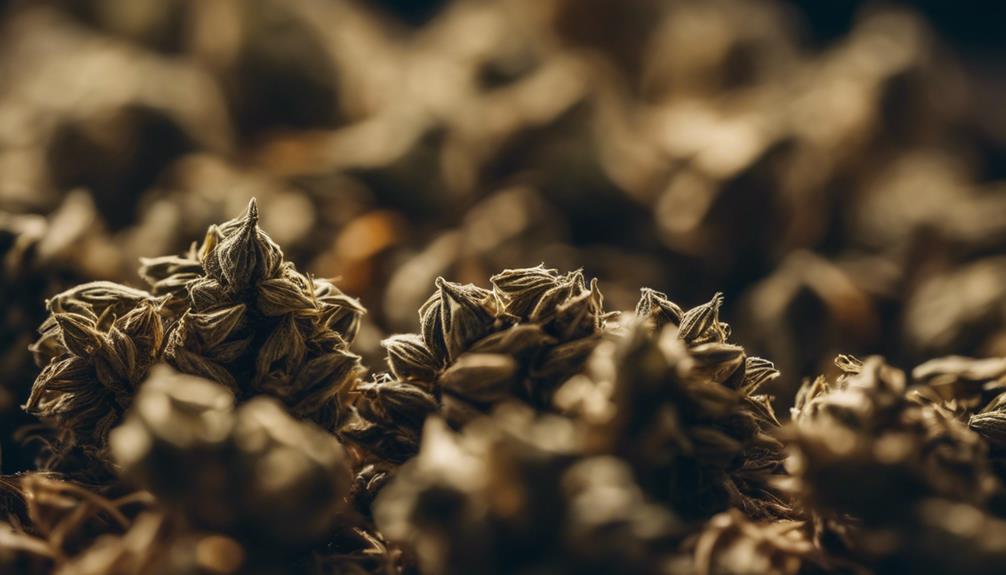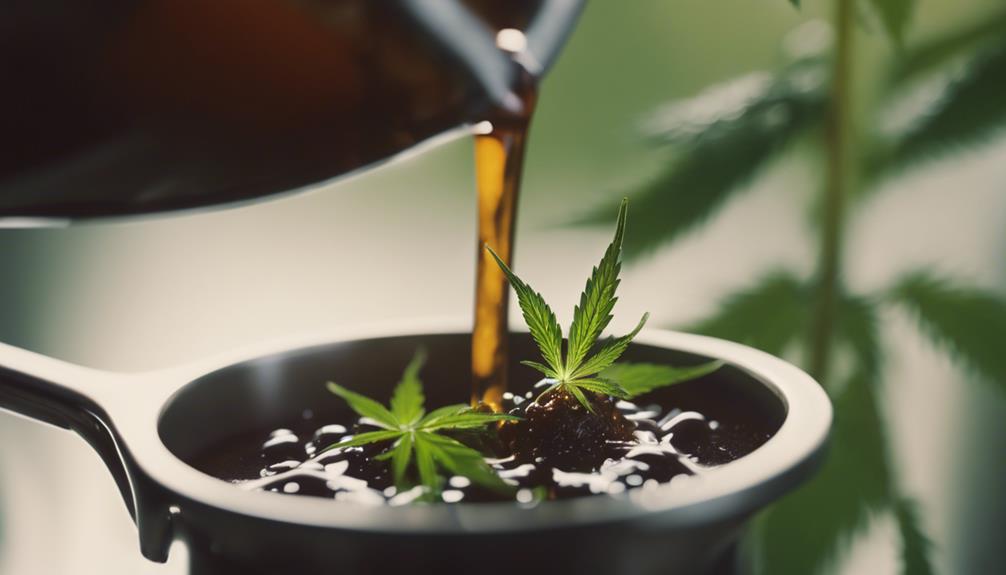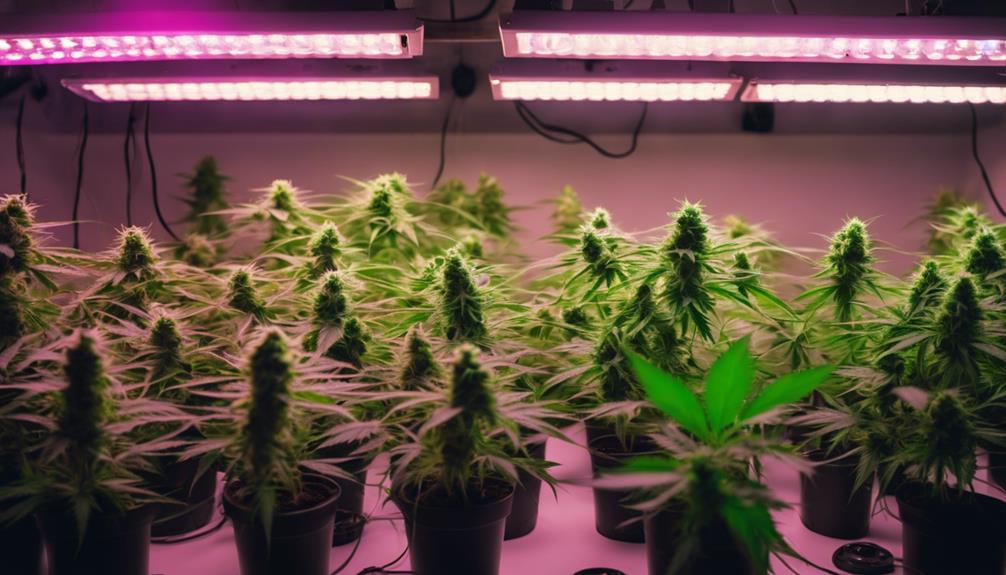Improper drying causes hay-like smell in cannabis due to high temperatures and humidity, ideal for microbial breakdown of chlorophyll. This breakdown impacts plant quality greatly. Enzymes and bacteria are key players in intensifying the hay smell under improper conditions, making understanding vital for prevention. Environmental factors such as air circulation, temperature, and humidity control are essential to prevent and detect mold or bacterial presence. Better trimming practices, like removing excess leaves and uniform trimming, can help maintain bud quality. Ideal drying conditions and trimming practices guarantee excellent aroma. Learn more about the importance of proper drying and trimming techniques.
Key Takeaways
- Improper drying techniques create hay-like smell.
- Chlorophyll breakdown by microorganisms is a factor.
- Enzymes and bacteria influence the hay smell.
- Environmental factors and trimming affect aroma.
- Testing drying methods and preventive measures are crucial.
Improper Drying Techniques
Improper drying techniques can greatly impact the quality of cannabis buds, potentially leading to the development of a hay-like smell. When buds are dried under high temperatures or in environments with poor ventilation and humidity levels above 60%, it creates favorable conditions for microorganisms to thrive and break down chlorophyll in the buds, causing the hay smell.
This odor is primarily due to the presence of these microorganisms rather than over-drying. To prevent the hay smell, it's vital to monitor humidity levels, guarantee proper air circulation, and maintain a cool drying environment.
Effects of Chlorophyll Breakdown
Chlorophyll breakdown during the drying process of cannabis buds is a critical factor contributing to the development of the hay-like smell. When chlorophyll undergoes incomplete breakdown due to improper drying techniques, it results in the retention of excessive chlorophyll and the characteristic hay smell.
This incomplete breakdown can be influenced by bacterial action and enzymatic processes within the plant material. To maintain peak cannabis quality, it's crucial to guarantee that the drying process allows for the proper breakdown of chlorophyll. By controlling the drying conditions and facilitating complete chlorophyll breakdown, the undesirable hay smell can be minimized, preserving the overall quality and aroma of the cannabis product.
Role of Enzymes and Bacteria
Enzymes and bacteria play a significant role in the breakdown of chlorophyll in cannabis buds, influencing the development of the hay-like smell during the drying process.
Key Points:
- Enzymes and bacteria break down chlorophyll naturally during plant aging.
- Improper drying conditions can escalate enzyme and bacterial activity, intensifying the hay smell.
- Quality trimming, maintaining ideal humidity levels, and proper curing can regulate enzyme and bacterial action.
- Understanding the interplay of enzymes and bacteria is essential in preventing and addressing the hay smell in drying cannabis buds.
Factors Contributing to Hay Smell
Factors contributing to the hay smell in cannabis buds can be attributed to specific environmental conditions during the drying process. When drying cannabis buds, maintaining proper air circulation, temperature control, and humidity levels is vital in preventing the development of the undesirable hay smell. Microorganisms like mold or bacteria can also play a role in creating this aroma. Testing different drying methods and ensuring a controlled environment are essential steps in avoiding the hay smell issue. It's noteworthy that hay smell is not necessarily a result of over-drying or low humidity levels but rather the presence of specific microorganisms during the drying process. Taking preventive measures can greatly impact the final quality of the cannabis buds.
| Factors Contributing to Hay Smell | Role |
|---|---|
| Proper Air Circulation | Vital in preventing hay smell |
| Temperature Control | Helps regulate the drying process |
| Humidity Levels | Control prevents stagnation and mold growth |
Tips for Better Trimming
Implementing proper trimming techniques is essential for enhancing the quality and aroma of cannabis buds.
- Trim buds before drying: Prevents mold growth and hay smell development.
- Remove excess leaves: Allows for better airflow and lowers moisture levels.
- Trim close to main stem: Enhances curing process and maintains ideal smell.
- Ensure uniform trimming: Promotes uniform drying, leading to better aroma and taste.
Following these trimming techniques not only improves the overall look of the buds but also plays a significant role in reducing the risk of hay smell, enhancing airflow, preventing mold, and maintaining ideal moisture levels throughout the curing process.
Consistent and precise trimming is key to achieving high-quality cannabis with an ideal smell profile.
Importance of Ideal Humidity Levels
To maintain the best quality and aroma of cannabis buds, it's imperative to carefully regulate humidity levels during the drying process. Keeping humidity levels below 60% RH is essential to prevent the development of a hay smell. High humidity, especially in warm conditions, can promote the growth of microorganisms that cause this undesirable odor. Proper humidity control is essential to avoid hay smell, as close proximity of buds can lead to humidity stagnation.
Maintaining a cool environment with controlled humidity levels is key to preserving the quality of cannabis buds. Gentle air circulation is also important during drying to prevent over-drying and ensure the buds remain at an ideal moisture content. It's essential to monitor and maintain humidity levels to achieve the best results in curing buds.
Dark Period Before Harvest
The utilization of a dark period before harvest assists cannabis plants in breaking down chlorophyll, thereby reducing the hay smell present in the buds. This technique triggers plant responses that enhance aroma and flavor profiles, stimulating terpene production for a more robust scent.
Ensuring Proper Airflow During Curing
Proper airflow management during curing is essential for preserving the quality and aroma of cannabis buds. Adequate airflow plays a pivotal role in preventing mold and mildew growth, which can compromise the overall quality of the buds.
Good ventilation is key to maintaining consistent curing conditions and enhancing the smell and flavor profile of the cannabis. It also helps in regulating the moisture content within the buds, ensuring they reach the desired consistency.
Monitoring airflow levels throughout the curing process is imperative to prevent the development of undesirable odors like the hay smell. By optimizing airflow and ventilation, one can safeguard the integrity of the cannabis buds and achieve a high-quality end product.
Does the Taste of Cannabis Indicate Its Quality or Freshness?
When it comes to the taste of cannabis buds, it can indicate the quality and freshness of the product. A fresh, high-quality cannabis bud will have a pleasant, rich taste with notes of earthy, fruity, or floral flavors. A stale or low-quality bud may have a bitter, musty, or harsh taste.
Frequently Asked Questions
What Causes the Smell of Hay?
Hay fermentation, mold growth, environmental factors, and harvest techniques influence the smell of hay in cannabis. Soil composition, drying methods, storage conditions, nutrient deficiencies, genetics, and curing process all impact the final aroma.
What Is the Bad Smell Cannabis?
The bad smell in cannabis can be influenced by terpene profiles, genetics, and environmental factors. Proper growing, curing, and storage, along with addressing nutrient deficiencies and mold prevention, can help preserve aroma and enhance quality.
Does Bud Rot Have a Smell?
Bud rot, a common issue in cannabis, emits a distinctive musty odor due to mold growth. Detecting it early through bud inspection, proper storage, humidity control, and drying techniques is essential for quality assurance and odor elimination.
What Does Hay Smell Like?
Hay smell is a combination of fresh grass, earthy tones, sweet aroma, floral scents, and woody notes. It evokes memories of outdoor air, farm animals, summer fields, and dry hay in haystacks.
Conclusion
In summary, the hay smell in cannabis can be attributed to improper drying techniques, chlorophyll breakdown, enzymes, and bacteria.
Factors such as trimming, humidity levels, dark period before harvest, and airflow during curing play vital roles in maintaining the desired aroma of the plant.
By understanding and implementing these practices, growers can guarantee their cannabis retains its best scent profile.




